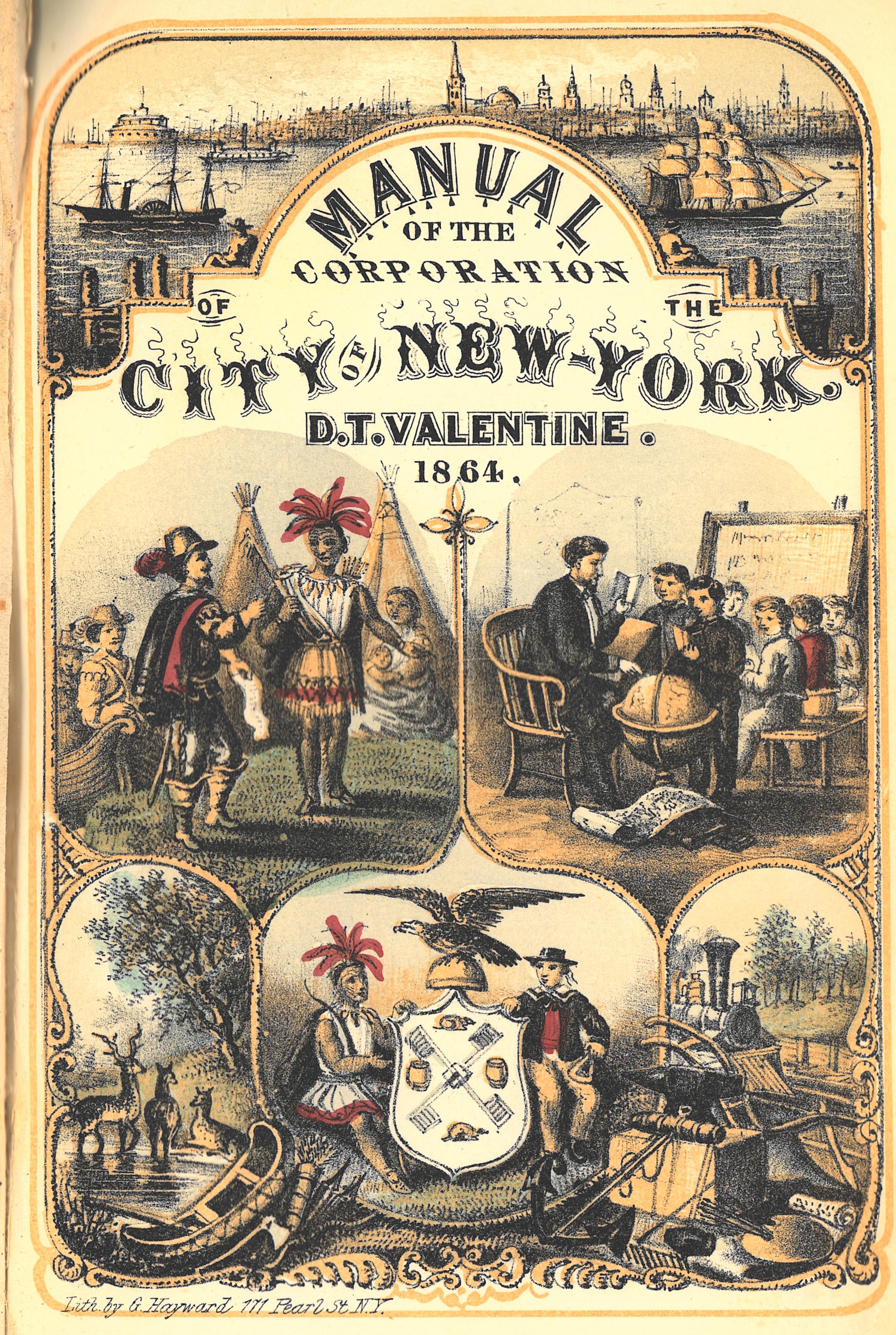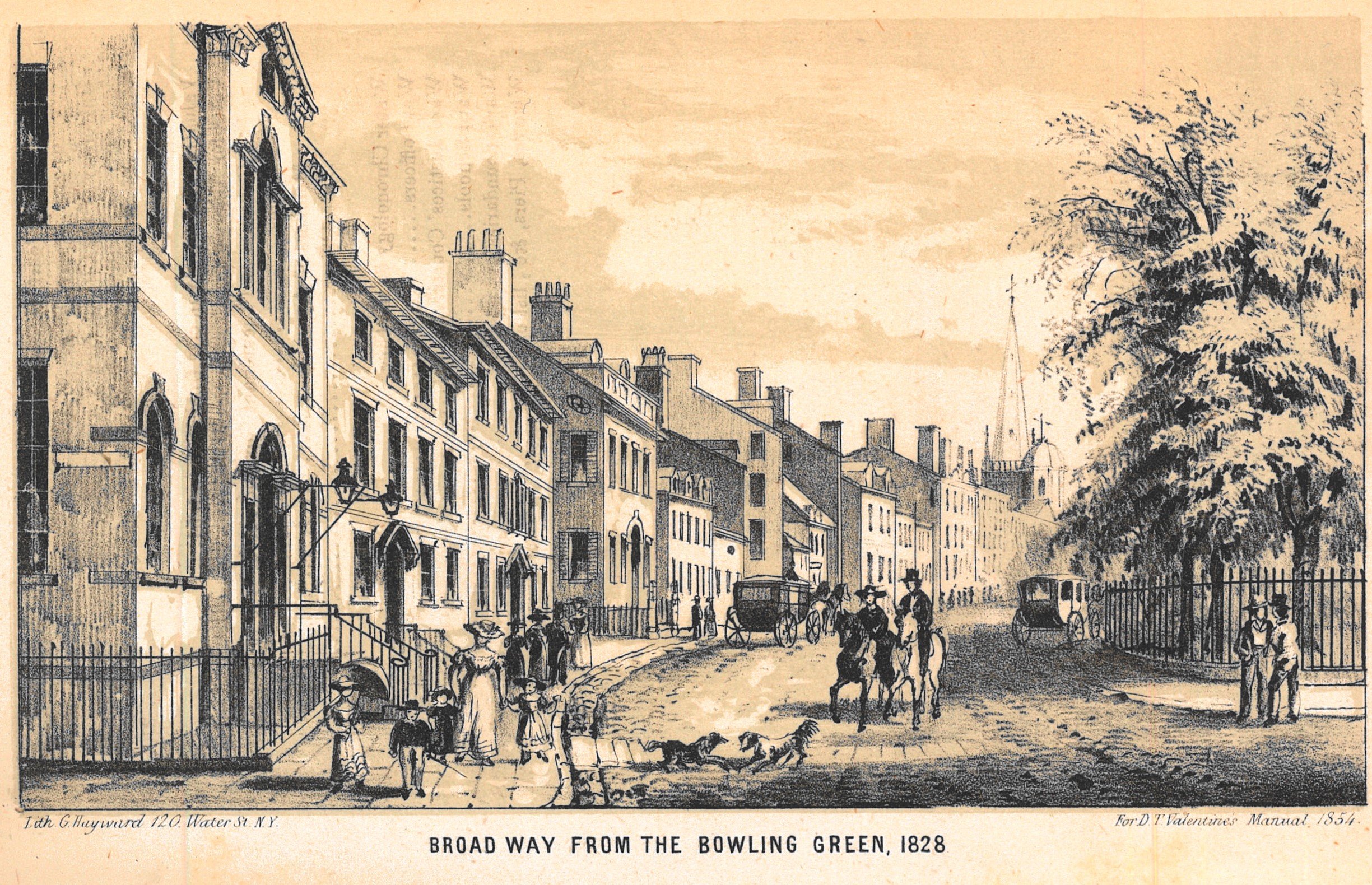For the Record readers may have observed articles are frequently illustrated with images copied from Valentine’s Manuals. Published annually between 1841 and 1870 (except 1867), and formally titled, Manuals of the Corporation of the City of New York, these volumes are a familiar source for information about municipal government, and particularly, graphic depictions of “old New York.”
Less well known is the related volume titled A General Index to The Manuals of the Corporation of the City of New York 1841-1870. First published in 1900 and 1906, and reprinted in 1981, the Index not only lists (and indexes) all of the plates, maps, plans, and facsimile letters and documents, and their locations, in the Manuals, but also includes an introduction with biographical information about the Manual compiler, David T. Valentine. The Municipal Library holds both the Index and copies of the Manuals.
Manual of the Corporation of the City of New York, 1864, NYC Municipal Library.
Manual of the Corporation of the City of New York, 1859, NYC Municipal Library.
David Thomas Valentine, “our city’s chronicler,” as he was described in the Index introduction, was born in Eastchester (present-day North Bronx/Westchester County) on September 15, 1801. He became the Marine Court clerk in 1826. In 1830, the Common Council appointed him as Deputy Clerk. In 1845, he became Chief Clerk of the Council.
Broad Way from the Bowling Green, 1828, Lithograph, Manual of the Corporation of the City of New York, 1854, NYC Municipal Library
What immediately stands out in reading the introduction and biographical information about Valentine, is his role in preserving the city’s historical records. The Index quotes from a letter Valentine wrote in 1867 concerning the original Dutch records of the City: “They were not very attentively cared for, having been without readers for probably a century and more. No attempt had been made to translate them; and of the history of New Amsterdam . . . was not supposed to lie hidden in these dusty, unbound and forbidding volumes.”
Fulton Ferry, New York, 1853, Lithograph, Manual of the Corporation of the City of New York, 1864, NYC Municipal Library.
The impetus for publication of the Manuals is stated in the preface of the first (1841/42) volume: “It having been thought expedient to enlarge the substance of the City Hall Directory, as heretofore annually published, by the introduction of additional matter interesting and useful to members of the Corporation and others connected with them, the contents and form of this volume have been selected as most useful and convenient for reference.”
Thanks to Valentine, described as “a man of antiquarian tastes and imbued with civic love and pride,” and “who possessed the patience and perseverance to dig and delve among these dingy records of the past” the Manuals are much, much more than simple directories.
Nursery Establishment, Randall’s Island, Lithograph, Manual of the Corporation of the City of New York, 1849, NYC Municipal Library.
The first two volumes, 1841-42, and 1842-43, contain predictable information, e.g. the names of all officials, standing committees of the Board of Aldermen and Assistant Aldermen, the Board of Supervisors, Board of Health, courts, etc. There is also helpful information about ferry schedules, hackney coach rates, the value of real and personal property in the city, and other data.
Central Park, The Terrace, Lithograph, Manual of the Corporation of the City of New York, 1864, NYC Municipal Library.
Beginning with the third volume, 1844-45, however, Valentine began inserting historical data, extracts from old newspapers, transcripts of early records, as well as lithographed illustrations. In the preface to the 1845/46 Manual, Valentine wrote“…in the selection of materials the Compiler flatters himself that he has bestowed unusual care, and has diligently explored the civic records and annals of our Municipal Government from the earliest period, he fully believes that he has rescued many facts and interesting documents from oblivion, to which they were hastening down the stream of time.”
Brooks Clothing Store, Catharine St., NY, 1845, Lithograph, Manual of the Corporation of the City of New York, 1864, NYC Municipal Library.
As described in the Index, Valentine “appears to have unearthed nearly every painting, print, drawing and map of important that bears any relation to our city, from the earliest settlement of the Island of Manhattan” and inserted good quality lithographed copies in the Manuals.
View of the Quarantine Grounds and Buildings, Staten Island, May 1858, Lithograph, Manual of the Corporation of the City of New York, 1859, NYC Municipal Library.
The preface to the Manual of 1856 further explains Valentine’s intention to “present an epitome of our early history.” Valentine wrote that “the present rapid progress of the City which promises soon to obliterate all the natural landmarks of the island,” led him to support the “preservation of views of such localities as now present noticeable features in the natural formation of the island, of old dwellings, farmhouses, country-seats, etc. as well as of the more prominent buildings, private and public, which denote the present fashions of architecture.”
Map of the City of New York, Manual of the Corporation of the City of New York, 1852, NYC Municipal Library.
Obsolete Names of Localities in the City of New York, Manual of the Corporation of the City of New York, 1856, NYC Municipal Library.
The 1866 volume was the last prepared by Valentine; no manual was issued in 1867. Valentine’s successor to the clerkship, Joseph Shannon, prepared the volumes for 1868 and 1869. The last volume, 1870, was produced by Shannon’s successor John Hardy.
Old Jail, City Hall Park, Lithograph, Manual of the Corporation of the City of New York, 1849, NYC Municipal Library.
David Valentine retired as Clerk in January 1868. He died in Manhattan on February 25, 1869. The Index introduction notes that in 1851 the Common Council appropriated five hundred dollars to purchase a portrait of Mr. Valentine “in recognition of his long and faithful services.” It was painted by C. W. Jarvis, “an artist of some ability,” according to the Index.
David T. Valentine, Portrait, Manual of the Corporation of the City of New York, 1859, NYC Municipal Library.
When the City began publishing the Official Directory of the City of New York (a.k.a. the Green Book), in 1918, the introduction stated “The need of a comprehensive directory of City Departments has long been recognized, but it has remained for the present administration to issue the first edition.” Further research might explain the more than forty-year interruption. However, basic information about New York City municipal government did appear in privately-published directories of City residents (Longworth’s Trow’s, etc.) through the 1930s and subsequently in telephone directories.
Long recognized for their historical and graphic value, Valentine’s Manuals of the Corporation of the City of New York “are indeed a mine of wealth to every one interested in the history of this great city.”











